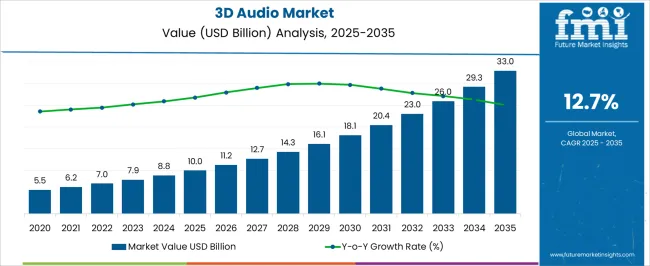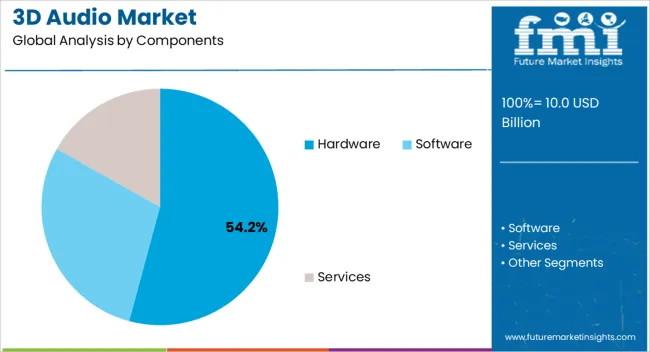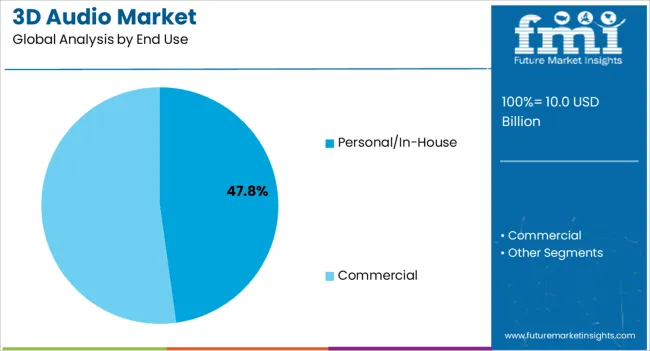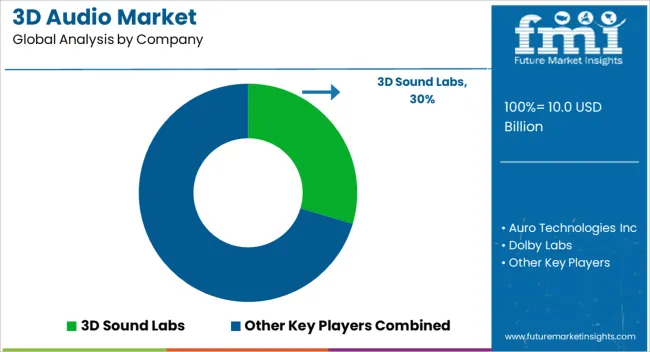The 3D Audio Market is estimated to be valued at USD 10.0 billion in 2025 and is projected to reach USD 33.0 billion by 2035, registering a compound annual growth rate (CAGR) of 12.7% over the forecast period.

| Metric | Value |
|---|---|
| 3D Audio Market Estimated Value in (2025 E) | USD 10.0 billion |
| 3D Audio Market Forecast Value in (2035 F) | USD 33.0 billion |
| Forecast CAGR (2025 to 2035) | 12.7% |
The 3D audio market is expanding steadily owing to increasing consumer demand for immersive sound experiences across entertainment, gaming, and virtual environments. Advancements in surround sound systems, spatial audio technologies, and integration with AR and VR platforms are reinforcing adoption across both professional and personal use cases.
The rise of streaming services, home entertainment systems, and wearable audio devices has further supported widespread deployment. Hardware innovations such as advanced speakers, headphones, and soundbars are playing a pivotal role in delivering enhanced audio precision and depth.
Regulatory support for accessible audio technologies and strong investment in R&D by audio technology firms are accelerating market penetration. The outlook remains positive with sustained opportunities in consumer electronics, automotive infotainment, and enterprise collaboration, where realistic soundscapes are seen as essential to user experience enhancement.

The hardware segment is projected to account for 54.20% of the total market revenue by 2025, making it the leading component category. This dominance is being driven by consistent advancements in speaker arrays, headphones, and VR headsets that deliver spatially accurate sound reproduction.
Hardware solutions are critical in providing the physical infrastructure necessary for high quality 3D sound output. Growing consumer investment in premium audio devices for gaming, cinema, and home entertainment has reinforced demand.
Additionally, integration of 3D sound capabilities into consumer electronics and automotive systems has further elevated adoption. The segment’s leadership is underpinned by the tangible and indispensable role of hardware in ensuring immersive audio experiences across industries.

The personal and in house segment is expected to hold 47.80% of the total market revenue by 2025, making it the most prominent end use category. Rising consumer inclination toward immersive entertainment experiences, including gaming, music streaming, and home theater systems, has strongly contributed to this growth.
Affordable access to high quality 3D audio hardware and the growing popularity of VR and AR applications for personal use have reinforced adoption. Increased time spent on at home digital entertainment platforms and hybrid work environments has further encouraged investment in advanced sound systems.
This segment continues to dominate as consumers increasingly prioritize premium audio quality in everyday entertainment and lifestyle activities.
As per the 3D audio industry research by Future Market Insights - historically, from 2020 to 2025, the market value of the 3D Audio industry increased at around 3.5% CAGR. Wherein, countries such as the United States of America, Germany, Japan, and Australia held a significant share of the global market.
The evolution of the market for 3D audio is largely dependent on parameters such as up-gradation in consumers’ requirements for audio products and accessories. Moreover, investments in research and development towards refinement of audio hardware and controls, and an increase in several applications.
3D audio products have a wide range of applications including automobiles, media, and entertainment, gaming among others. These are constantly multiplying over time, catering to the expansion of the 3D audio market size.
Exponential growth is evident in 3D audio technology, as companies are investing in research and development to provide a next-generation audio experience which leads to broader technological advancement in 3D audio. These factors are projected to accelerate the demand for the market during the year 2025 to 2035 with a projected CAGR of 13.3%.
The 3D Audio market has reached a valuation of USD 10 billion in 2025. Future Market Insights estimates that 3D Audio revenue grows more than double from 2025 to 2035, reaching nearly USD 33 billion in 2035.
North America has a strong presence of prominent technology companies, content creators, and audio equipment manufacturers who are actively investing in and developing 3D audio technologies. This concentration of industry players fosters innovation and drives the growth of the market.
As per FMI, the market for 3D audio in North America accounted for about 30.4% of the value share on a global level in 2025.
The region also has high consumer demand for immersive audio experiences, particularly in sectors such as gaming, virtual reality (VR), and entertainment. North American consumers are early adopters of new technologies and are willing to invest in premium audio equipment and content. Creating a favorable market environment for 3D audio solutions.
The United States of America has emerged as a leader in revenue generation in the 3D audio market due to its robust and dynamic technology industry. With numerous companies at the forefront of audio innovation, contributing to the region’s value share of 16.5% in 2025.
Companies in this country invest heavily in research and development to create state-of-the-art 3D audio solutions that cater to the growing demand for immersive audio experiences.
The United States also boasts a strong ecosystem of audio equipment manufacturers, software developers, and content creators. Contributing to the overall growth and success of the 3D audio market.
Asia Pacific is projected to enroll a decent CAGR in the 3D audio market during the forecast period owing to the expanded interest in 3D Audio in emerging countries. Particularly India and China, owing to growing expenditure among various consumers towards music.
The demand for 3D sound quality in the Asia Pacific is also on surge due to the gaming and media and entertainment industries. As they can show content more effectively to the consumer.
The market for 3D audio in India is anticipated to move forward at 14.4% CAGR from 2025 to 2035, following FMI research.
China has a prominent share in the gaming and media and entertainment industry facilitating its growth rate of 12.2% during the forecast period.
Significant investments are coming from various domestic players and venture capitalists for 3D audio technology in India and China. This is expected to accelerate the 3D audio industry in the Asia Pacific.
The commercial segment was predicted to capture a share of 62.2% in 2025 owing to developments in the market. Such as HRTF, noise cancellation, and implementation of sensors, which have led the market to trace a profitable path.
Deployment of 3D audio technology into automobiles, cinema, music, gaming, museum, VR concert, and gaming has increased the scope of the market more prominently. In the cinema, industry especially in the sound engineering division, 3D audio is being used to offer viewers an enhanced experience.
Exploration and development activities in the automobile sector regarding 3D audio are implemented. For the real environment experience while driving and to feel the natural sound within the car cabin 3D audio is actuated with the sensors.
The combination of 3D audio and sensors is playing a pivotal role in the automobile industry and may drive the sales of 3D audio-enabled music systems in the automobile industry.
The hardware component is expected to be at the forefront of the market based on the component segment due to several factors. The hardware components play a crucial role in delivering an immersive and realistic 3D audio experience. This includes headphones, speakers, amplifiers, and sound bars, which are essential for capturing, processing, and spatially reproducing the audio.
Advancements in hardware technologies have significantly improved the capabilities of these components, offering higher sound quality, improved spatialization, and enhanced user experience fostering the sub-segment share of 45.2% in 2025 on a global level.

The competition in the market for 3D audio is intense, with several key players vying for market share and striving to differentiate themselves through innovative solutions and technologies.
The market is witnessing a growth in companies entering the space, both established players and new entrants, further intensifying the competition. These players compete on various factors such as product offerings, technological advancements, pricing strategies, distribution channels, and customer relationships.
Key Players:
Some Recent Developments:
The global 3D audio market is estimated to be valued at USD 10.0 billion in 2025.
The market size for the 3D audio market is projected to reach USD 33.0 billion by 2035.
The 3D audio market is expected to grow at a 12.7% CAGR between 2025 and 2035.
The key product types in 3D audio market are hardware, _loud speaker, _headphones, _microphones/mic, _soundbars, _others, software and services.
In terms of end use, personal/in-house segment to command 47.8% share in the 3D audio market in 2025.






Full Research Suite comprises of:
Market outlook & trends analysis
Interviews & case studies
Strategic recommendations
Vendor profiles & capabilities analysis
5-year forecasts
8 regions and 60+ country-level data splits
Market segment data splits
12 months of continuous data updates
DELIVERED AS:
PDF EXCEL ONLINE
3D Printed Dental Brace Market Size and Share Forecast Outlook 2025 to 2035
3D Reverse Engineering Software Market Forecast and Outlook 2025 to 2035
3D Automatic Optical Inspection Machine Market Size and Share Forecast Outlook 2025 to 2035
3D Ready Organoid Expansion Service Market Size and Share Forecast Outlook 2025 to 2035
3D Imaging Surgical Solution Market Size and Share Forecast Outlook 2025 to 2035
3D-Printed Prosthetic Implants Market Size and Share Forecast Outlook 2025 to 2035
3D Printing Ceramics Market Size and Share Forecast Outlook 2025 to 2035
3D NAND Flash Memory Market Size and Share Forecast Outlook 2025 to 2035
3D Printing Metal Market Size and Share Forecast Outlook 2025 to 2035
3D Bioprinted Organ Transplants Market Size and Share Forecast Outlook 2025 to 2035
3D Mapping and Modeling Market Size and Share Forecast Outlook 2025 to 2035
3D Printing in Aerospace and Defense Market Analysis - Size, Share, and Forecast Outlook 2025 to 2035
3D Printed Maxillofacial Implants Market Size and Share Forecast Outlook 2025 to 2035
3D Surgical Microscope Systems Market Size and Share Forecast Outlook 2025 to 2035
3D-Printed Personalized Masks Market Size and Share Forecast Outlook 2025 to 2035
3D Printing Market Size and Share Forecast Outlook 2025 to 2035
3D Printed Packaging Market Size and Share Forecast Outlook 2025 to 2035
3D Printed Clear Dental Aligners Market Size and Share Forecast Outlook 2025 to 2035
3D IC and 2.5D IC Packaging Market Size and Share Forecast Outlook 2025 to 2035
3d-Printed Skincare Market Analysis - Size and Share Forecast Outlook 2025 to 2035

Thank you!
You will receive an email from our Business Development Manager. Please be sure to check your SPAM/JUNK folder too.
Chat With
MaRIA